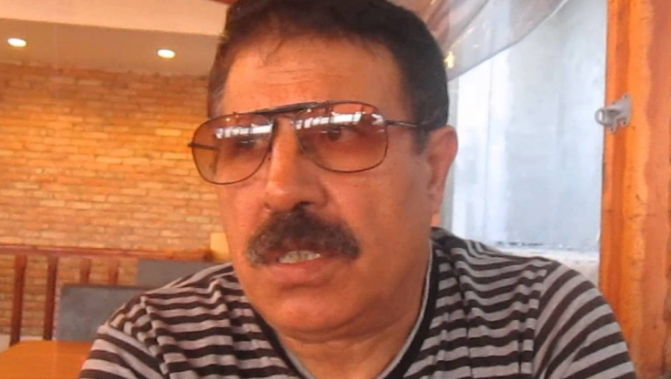It’s been described by critics as San Pedro’s “ticking time bomb.” Officials, however, have said through the years that safety measures are in place and the site passes frequent inspections.
The butane and propane facility, Rancho LPG, has operated near the Port of Los Angeles for more than 50 years adjacent to homes, businesses and schools.
For more than two decades, resident-led efforts to force out the storage facility at 2110 N. Gaffey St. in San Pedro have repeatedly failed. Despite the support of numerous area lawmakers through the years, there appears to be no option to move the facility. It’s been in operation since the early 1970s (under a different owner). Owners say they’d be looking at millions of dollars to move out of the area.
Los Angeles City Council Member for the 15th District, Tim McOsker, (Sam Gangwer, Contributing Photographer)
Rancho LPG LLC Holdings Facility sits on private property with a long-term lease and has been subject to frequent inspections that have found it in compliance with safety laws. It includes two above-ground 12.5 million-gallon refrigerated tanks and five above-ground 60,000-gallon horizontal storage tanks.
But Los Angeles City Councilman Tim McOsker, since taking office nearly a year and a half ago, has embarked on a push to end butane and propane storage on the property.
McOsker introduced a motion on Tuesday, April 2, calling for the city to explore requesting an amortization study to provide information he said “can lead to the termination of the use and help address the remediation of the site for the safety of local residents and the greater Los Angeles community.”
The company, based in Texas, pointed to Rancho’s safety record through a spokesperson.
“Rancho LPG has safely operated for more than 40 years with ongoing oversight from multiple local, state, and federal regulators,” said Morgan Ash, spokesperson, in a written comment. “We’ve made numerous upgrades and safety enhancements since we purchased the site in 2008. We remain committed to safe operations in the community.”
As a first step, McOsker’s motion requests a report back on the feasibility of amending current city land use codes in connection with health impacts at oil and gas wells and drill sites to apply to the Rancho facility.
The councilmember points to a City Council motion from 2017 that led to a policy adoption and budget considerations relative to amortization studies as the city phases out oil and gas land uses and production within the city.
McOsker argues that Rancho, while not a drill site, should still fall under that policy as it:
Fails to meet the setback requirements of 200 feet from neighboring land use;
Is surrounded by uses on all sides including an oil refinery, a soccer field, and businesses; and
Has failed to get the required permits in a timely fashion from the South Coast air Quality Management Division after it became the owner of the facility.
“Multiple motions have attempted to address this facility,” he wrote in the request. “It is time for the city council to seek an amortization study that can provide the expert information that can lead to the termination of the Rancho LPG Facility use as well as help address the remediation of the site for the safety of local residents and the greater Los Angeles community.”
McOsker’s motion requests that the Office of Petroleum and Natural Gas Administration and Safety — in coordination with the Department of City Planning, the Los Angeles Fire Department, and the City Administrative Officer — “expeditiously report on the cost and timeline associated to conduct an amortization study related to termination of the Rancho LPG Facility use. The results of the study should be used to inform policy and decisions related to the future of the site and its land use.”
Earlier, questions from critics were directed to the Port of Los Angeles regarding a port rail spur used for the products at Rancho.
Port responses to those inquiries said it cannot impose restrictions on those operations as rail carriers have “not only a right, but a statutory common carrier obligation, to transport hazardous materials upon reasonable requests” and thus those requests for restrictions are preempted, a port statement said.
Janet Schaaf-Gunter of San Pedro Homeowners United expressed encouragement after spending 20 years in the movement to move the tanks.
“A litany of elected representatives have for years feigned their concerns about the facility without engaging in any serious effort to address that risk,” she said in a written comment. “At least… until now.”
McOsker’s motion, seconded by Councilmember Heather Hutt, was referred to the council’s Energy and Environment Committee.
Led initially by a coalition of homeowners groups and neighborhood council members, the longstanding effort to force the company to move its operation has sparked various protests, studies and community meetings through the years.
Critics, including former Los Angeles Unified school board member Richard Vladovic in 2014, have said the chance of an accident can never be predicted.
“Folks, accidents happen,” Vladovic said at a 2013 meeting held at Taper Avenue Elementary School that is within sight of the tanks. “You couldn’t build that here today.”
A terrorism risk expert at that meeting, Carl Southwell, said while it’s “highly unlikely to occur,” a deadly accident is possible. “I think the best response to a disaster is to prevent it.”
Recent events, Schaaf-Gunter added, may now be drawing more attention to the issue.
“With the convergence of the Baltimore bridge collapse and now the 7.4 quake in Taiwan, there appears to be a bit more concern about the hard reality of the Rancho LPG facility and its highly explosive opportunity,” Schaaf-Gunter said, noting also the earthquake faults that through the L.A. coastal zone.
In his motion, McOsker said the most recent studies conducted “indicate that a catastrophic incident at the Rancho LPG Facility, with a release of butane, could potentially cause more than 2,500 deaths and 12,500 injuries and also major destruction for the Port of Los Angeles and its infrastructure.”
In 2014, federal officials from anti-terrorism and environmental protection departments assured some 200 residents that Rancho LPG was in full compliance with U.S. regulations. The forum was organized by then-U.S. Rep. Henry Waxman, D-Manhattan Beach.
Related Articles
LA County starts distributing 60,000 free gun safety locks
LA County law enforcement officers killed by bandits honored in Irvine — 167 years later
Libraries expand naloxone clinics, training at Los Angeles County libraries
West Covina’s breakaway health department could be approved by end of year; the mayor has questions
Anne Miskey, CEO of Pasadena’s Union Station Homeless Services, announces resignation





